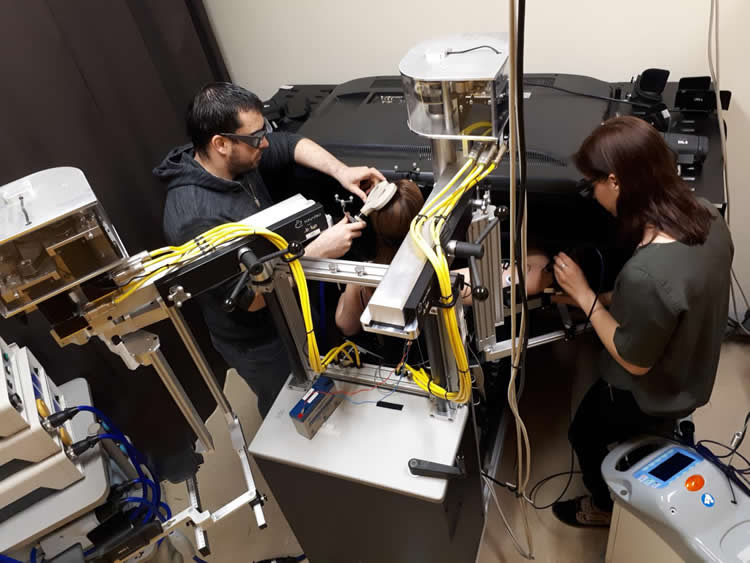Summary: A new study reports, following an injury, the motor areas of the brain reduce signaling to a muscle if the muscle is responsible for producing painful movements, but enhances signaling if the muscle counteracts the painful movement.
Source: The Physiological Society.
When people are injured, how does the brain adapt the body’s movements to help avoid pain? New research published in The Journal of Physiology investigates this question.
After an injury, our body will rapidly associate pain to a particular movement and modify which muscles we use accordingly. This new research shows that the message from motor brain areas toward a muscle is reduced if this muscle is responsible for producing a painful movement and increased if it the muscle counteracts that movement.
They also observed that if the brain knows the movement will cause pain then the reaction time to perform the movement is longer, but the movements are performed quicker, suggesting a strategy of ‘getting it over and done with’.
This shows that the brain is able to anticipate that particular movements will cause pain, allowing us to adapt and move differently. This research is focused on how the body responds to the anticipation of an experimental acute pain (i.e. a transient pain lasting a fraction of a second during the execution of a movement) but it may be possible to use these findings to help preventing musculoskeletal pain disorders.
When people are injured they can quickly learn to associate pain to a given movement and change the way the body moves to avoid or minimize pain. Understanding how this occurs in the brain is crucial for identifying the mechanisms that lead to the long-term maintenance of pain.

The research conducted by Laval University, Quebec, in conjunction with the Center for Interdisciplinary Research in Rehabilitation and Social Integration, Quebec, involved measuring the link between motor brain areas and the biceps as they prepared to move. The investigation was carried out on thirty healthy participants, in which half received painful stimulations during flexion movements and the other half during extension movements.
Importantly, as the experimental pain was induced with laser simulations, the results cannot be directly transferred to a population of patients suffering from clinical pain.
Catherine Mercier, corresponding author of the study, said:
‘This discovery is important because it confirms the establishment of protective strategies during the anticipation of acute pain. It marks an important advance to further our understanding of the mechanisms involved in the transition from acute to chronic pain. Indeed, a recent theory on the effect of pain on motor control states that while protective strategies may be initially relevant and lead to short-term pain alleviation, they may potentially have detrimental long-term consequences and lead to chronic pain.’
Source: Andrew Mackenzie – The Physiological Society
Publisher: Organized by NeuroscienceNews.com.
Image Source: NeuroscienceNews.com image is credited to Michaël Bertrand-Charette.
Original Research: Open access research for “Effect of movement‐related pain on behaviour and corticospinal excitability changes associated with arm movement preparation” by Cécilia Neige, Nicolas Mavromatis, Martin Gagné, Laurent J. Bouyer, and Catherine Mercier in The Journal of Physiology. Published May 31 2018.
doi:10.1113/JP276011
[cbtabs][cbtab title=”MLA”]The Physiological Society “The Brain is Able to Anticipate Painful Movements Following Injury.” NeuroscienceNews. NeuroscienceNews, 1 June 2018.
<https://neurosciencenews.com/pain-movement-injury-9211/>.[/cbtab][cbtab title=”APA”]The Physiological Society (2018, June 1). The Brain is Able to Anticipate Painful Movements Following Injury. NeuroscienceNews. Retrieved June 1, 2018 from https://neurosciencenews.com/pain-movement-injury-9211/[/cbtab][cbtab title=”Chicago”]The Physiological Society “The Brain is Able to Anticipate Painful Movements Following Injury.” https://neurosciencenews.com/pain-movement-injury-9211/ (accessed June 1, 2018).[/cbtab][/cbtabs]
Abstract
Effect of movement‐related pain on behaviour and corticospinal excitability changes associated with arm movement preparation
When a movement repeatedly generates pain, we anticipate movement‐related pain and establish self‐protective strategies during motor preparation, but the underlying mechanisms remains poorly understood. The current study investigated the effect of movement‐related pain anticipation on the modulation of behaviour and corticospinal excitability during the preparation of arm movements. Participants completed an instructed‐delay reaction‐time (RT) task consisting of elbow flexions and extensions instructed by visual cues. Nociceptive laser stimulations (unconditioned stimuli) were applied to the lateral epicondyle during movement execution in a specific direction (CS+) but not in the other (CS−), depending on experimental group. During motor preparation, transcranial magnetic stimulation was used to measure corticospinal excitability in the biceps brachii (BB). RT and peak end‐point velocity were also measured. Neurophysiological results revealed an opposite modulation of corticospinal excitability in BB depending on whether it plays an agonist (i.e. flexion) or antagonist (i.e. extension) role for the CS+ movements (P < 0.001). Moreover, behavioural results showed that for the CS+ movements RT did not change relative to baseline, whereas the CS− movements were initiated more quickly (P = 0.023) and the CS+ flexion movements were faster relative to the CS− flexion movements (P < 0.001). This is consistent with the pain adaptation theory which proposes that in order to protect the body from further pain, agonist muscle activity is reduced and antagonist muscle activity is increased. If these strategies are initially relevant and lead to short‐term pain alleviation, they may potentially have detrimental long‐term consequences and lead to the development of chronic pain.






